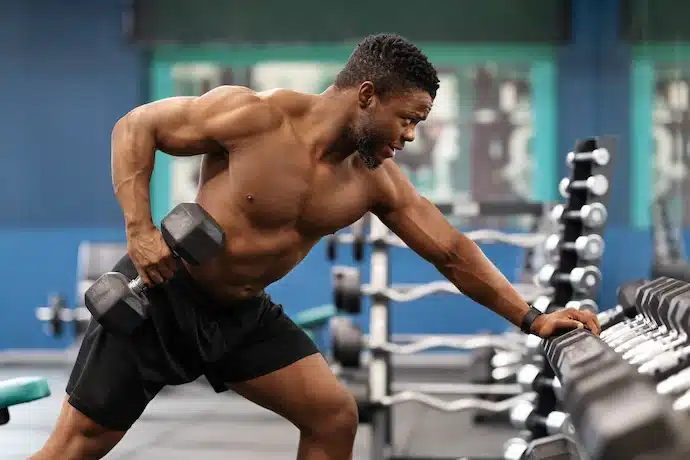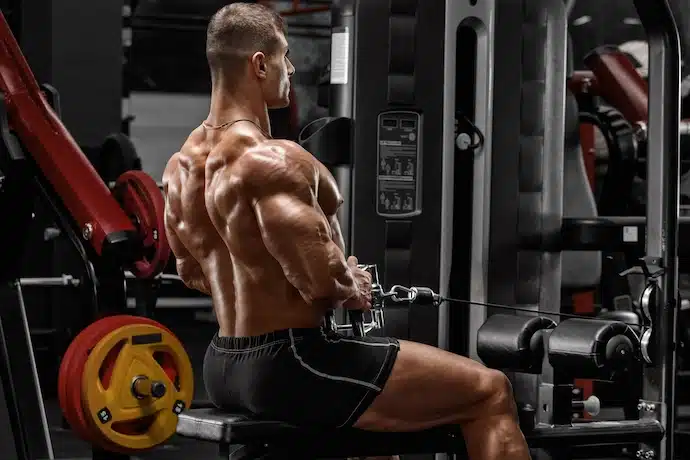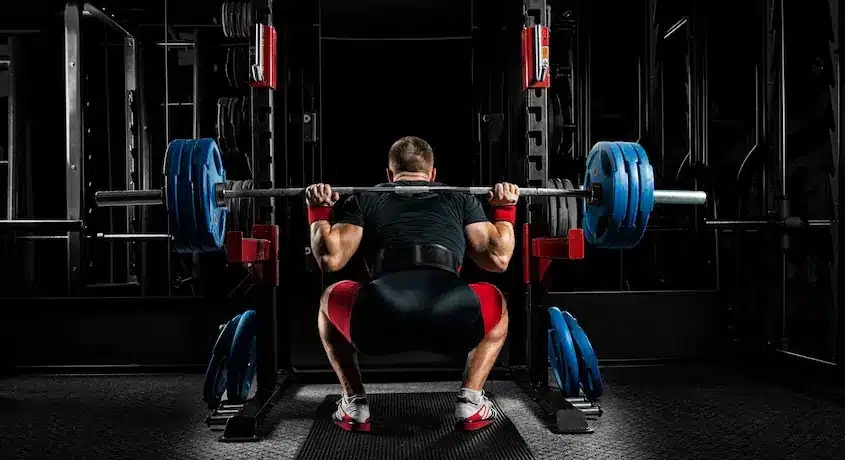Are you stuck in your muscle-building journey? Dumbbell rows are key for a stronger back, shoulders, and arms. This article will guide you through the best row variations to power up your workout.
- Overview of Rowing Variations
- Barbell Row for Muscle Building
- Dumbbell Row for Versatility
- Machine/Cable Row for Controlled Movements
- Kroc Row for Grip Strength and Power
- Pendlay Row for Explosive Power
- Comparing Row Variations
- Incorporating Rows into Your Workout
- Conclusion
- FAQs
- 1. What are some variations of row exercises for muscle building?
- 2. How does the position of my body parts affect my performance in these exercises?
- 3. Can using different equipment enhance my workout during these exercises?
- 4. Are chin-ups effective in muscle building as well?
- 5. I’ve heard about starting strength methods in bodybuilding – what is it exactly?
- 6. Do nutritionists play any role in helping me build muscle through these variations of rows?
Key Takeaways
- Barbell rows help you lift heavy weights, which is good for building up your back and arms.
- Dumbbell rows let you fix muscle imbalances by working one side of your body at a time. This makes both sides strong.
- Machine/cable rows keep your form right and are safer for beginners. They help focus on back muscles without hurting your lower back.
- Kroc rows increase grip strength and challenge upper body with heavy weights but need careful attention to avoid injury.
- Pendlay rows demand proper form and explosive power, targeting many back muscles at once from a complete stop each rep.
Overview of Rowing Variations
In the gym, you can try many kinds of row exercises. Each type uses different tools like barbells, hand weights, or machines to work out your muscles in unique ways.
Barbell Row
Barbell Row targets big muscles in your upper and middle back. You can lift heavy with this move, which is great for growing muscle and getting stronger. By adding more weight over time, you keep challenging your body.
This exercise also works your lower back, but you have to do it right to avoid hurting yourself. It’s key for a strong posterior chain, which includes all the muscles on the back side of your body from your heels to your head.
Dumbbell Row
Dumbbell Row targets your back muscles like the lats, rhomboids, and traps. This exercise is great for fixing muscle imbalances since you work each side of your body one at a time.
It’s kinder on your lower back too. You can focus on different parts of your back by changing angles.
This row is tough to add more weight to over time compared to barbell rows. You need dumbbells to do it, which might be hard for new people starting out. Yet, it’s a solid choice for gym goers wanting to strengthen and balance their upper body without extra stress on their spine.
Machine/Cable Row
Machine/cable row uses a cable or lever machine. This targets your back muscles well. The chest support is great because it reduces stress on your lower back. This makes it easier for beginners since there’s less free range of motion.
With this workout, you get to really focus on your back muscles. Different machines might feel different. So, trying various ones can keep the exercise fresh.
Kroc Row
Kroc rows are tough. They use a heavy dumbbell to test your grip strength and push your muscles hard. This exercise is a beast for making your upper back strong. You grab the biggest weight you can hold and pull it, aiming for lots of reps.
Your hands will feel the burn, proving it’s working.
This move isn’t for gym newbies. The risk of hurting yourself goes up because you’re using so much weight and momentum. To do it right, keep an eye on your form throughout each pull.
It demands big dumbbells and a solid grip but pays off by bulking up your upper back like no other row does.
Pendlay Row
Pendlay Row starts with lifting a barbell from the ground to your chest. You keep your back straight, using muscles in your upper back and lower back. This move asks for a dead stop at the start of each lift.
It means you lift from a complete stop every time. This helps make sure you use good form.
Pendlay Row boosts explosive power, key for sports.
This row works many muscles, like those along your spine and shoulders. Yet, it’s tough for beginners since they must learn how to lift correctly from a pause. You need weights and a barbell to do this exercise.
Next, let’s look at comparing row variations.
Barbell Row for Muscle Building
Barbell Row powers up your upper body like no other move. Grab a standard bar, bend over, and row to build those back muscles big time.
How to Perform Barbell Rows
Executing a barbell row correctly aids in developing muscles in your back and arms. It’s an essential exercise for enhancing strength.
- Equip the barbell with manageable weights.
- Stand maintaining shoulder-width distance between your feet.
- Incline at the waist until your upper body aligns almost parallel to the floor.
- Seize the bar with both hands, extending beyond shoulder width.
- Keep your back straight to prevent injuries.
- Slightly exert power through your legs to initiate the movement.
- Draw the barbell to your lower chest.
- Make sure your elbows extend beyond your back, not projecting sideways.
- Rapidly yet safely revert the bar to the onset position, consuming 1-2 seconds.
- Strive for 3-4 sets of 8-12 repetitions depending on your workout regimen.
Subsequently, let’s discuss the advantages of incorporating this exercise into your routine.
Benefits of Barbell Rows
Once you know how to do barbell rows, it’s clear why they’re great for building muscle. Using a standard barbell lets you lift heavier weights. This is key for growing your back muscles, like the latissimus dorsi and erector spinae.
It also hits your shoulders and biceps hard.
Barbell rows help with more than just size; they make your whole back stronger by working the upper arm bone and shoulder blades together. This exercise supports a strong posture too.
Plus, it sets the stage for other big lifts like squats, deadlifts, and bench presses.
Adding barbell rows to your routine paves the way for bigger gains in strength and muscle mass.
Limitations of Barbell Rows
After looking at the good points of barbell rows, we need to talk about some drawbacks. One big problem is they can hurt your lower back if you don’t do them right. This means you have to keep a neutral spine and not let your back curve.
If you’re lifting heavy without paying attention to form, the strain on your lower back grows.
Barbell rows also put a lot of work on the posterior chain – that’s muscles like your glutes and hamstrings. But, they don’t do much for smaller muscles in your back. So, if you’re trying to target those tiny muscles, this might not be the best exercise for you.
Dumbbell Row for Versatility
Dumbbell Row lets you move each arm alone. This freedom helps work more muscles in your body, making your workout better.
How to Perform Dumbbell Rows
Dumbbell rows target your back muscles like lats, rhomboids, and traps. They need good form to avoid hurting yourself.
- Stand with your feet shoulder-width apart.
- Bend your knees slightly.
- Lean forward from your waist. Keep your back straight.
- Hold a dumbbell in one hand with an overhand grip.
- Place your other hand on something sturdy, like a bench, for support.
- Let the dumbbell hang down at arm’s length.
- Pull the dumbbell up to the side of your chest.
- Your elbow should go past your back as you lift.
- Lower the dumbbell slowly back to the starting position.
Now, let’s talk about how to use cables for rows.
Benefits of Dumbbell Rows
Using dumbbells for rows helps fix muscle imbalances. This means each side of your body works alone, making both sides just as strong. It also puts less stress on your lower back. This is good because it lets you build a strong back without hurting yourself.
Dumbbells let you pull from different angles, hitting various parts of the back muscles like the lats and rhomboids. This makes your workout more effective in building a wide, muscular back.
Dumbbell rows force symmetry in strength and size.
Limitations of Dumbbell Rows
Dumbbell rows make it tough to add more weight as you get stronger. This is because they’re harder to overload than barbell rows. You might start light and work hard, but soon, adding extra pounds becomes a big challenge.
Plus, you need access to different dumbbells for each muscle group you want to work on. Not every gym has lots of weights or the exact ones you need.
For beginners, figuring out how much weight to use can be tricky too. If the weight is too light, you won’t build muscle well. Too heavy and you risk hurting yourself. Also, switching weights between exercises slows down your workout and tests your patience.
So while dumbbell rows are great for targeting muscles individually and can help fix strength imbalances, these limits may frustrate many gym goers looking for steady progress in their strength training routines.
Machine/Cable Row for Controlled Movements
The machine/cable row lets you move smoothly and keeps your form right. This helps avoid injuries while still working out hard. It uses machines or cables, giving you a stable way to pull weight.
You can change the weights easily to match your strength. This type of row is great for beginners or anyone who wants to build back muscles safely. Ready to learn more? Keep reading!
How to Perform Cable Rows
Utilizing a cable machine focuses precisely on your back muscles. It also presents you with the convenience of adjusting the weight to correlate with your strength level.
- Position yourself in front of the cable machine, arranging your feet at shoulder-width distance.
- Seize the handle with both hands. If it provides attachments, utilize a grip that provides comfort.
- Slightly flex your knees and lean forward from your hips. Maintain a straight posture with your back.
- Reel the handle towards you, aiming just below your chest. Keep your elbows near your body.
- As you pull back, make certain to contract your shoulder blades together.
- Gradually let the handle revert to the initial point, ensure the weight stack doesn’t make contact.
- Maintain a firm core during the entire exercise to provide stability to your lower back.
- Modify the seat or knee pad if the machine offers one, ensuring stability while pulling.
- Execute 3-4 rounds of 8-12 repetitions each for muscle enlargement.
This workout involves cable machines for regulated movements that activate multiple back muscles including lats and rear deltoids without exerting your spine, compliments to chest support on certain machines. Consistently maintain proper form during each repetition by following machine-specific instructions.
Benefits of Cable Rows
Once you know how to use the machine for rows, you’ll see why they’re great for your back muscles. Machine or cable rows help you control your movements better. This means each pull is smooth and targets your muscles just right.
Unlike free weights, cables keep a constant tension on your lats and posterior deltoids. This constant pull makes sure all parts of the muscle work hard during the exercise.
Cables are also safer for beginners because they limit how much the weight can move around. You won’t have to worry as much about getting hurt by dropping weights or moving in a bad way that could strain your back.
Plus, using a chest support on some machines means less stress on your lower back while still hitting those key areas like the rhomboid major near your spine and shoulder girdle.
Using controlled movements with cable machines isolates and builds back strength without risking injury.
Limitation of Cable Rows
After talking about the good points of cables, we see they have some downsides too. Cables might not let you move your arms as much as with free weights. This can mean you’re not working all your muscles fully.
Also, using machines means you might miss out on training those smaller muscles that help keep you stable.
Every cable machine feels a bit different from another. So, if you use one at a gym and then try another somewhere else, it might feel weird or wrong. These issues could make it harder for gym goers to get stronger in the best way possible.
Kroc Row for Grip Strength and Power
Kroc Row boosts your grip strength and powers up your lifts. It makes you hold a heavy dumbbell tightly and row hard.
How to Perform the Kroc Row
The Kroc Row is focused on augmenting grip strength and stimulating your back. Here’s how you perfect this exercise to increase your muscle mass:
- Position yourself adjacent to a weight bench, resting one knee and the corresponding hand on it for support.
- Hold your opposite foot on the ground, slightly away from the bench.
- Bend forward until your upper body is nearly parallel with the ground, but ensure your back remains straight.
- Take a dumbbell with your available hand using a strong grasp.
- Allow the dumbbell to suspend directly below your shoulder, arm elongated.
- Jerk the dumbbell upward to your hip briskly, holding your elbow tight to your body.
- Concentrate on contracting your back muscles as you elevate.
- Descend the weight leisurely back to the origin position.
- Complete all repetitions on one side prior to transitioning to the other side.
Keep these guidelines in consideration to prevent the application of excessive momentum; uphold a neutral spine throughout.
Subsequently, we’ll discuss how the integration of diverse row version can further boost your workout routine.
Benefits of the Kroc Row
Kroc rows boost your grip strength and upper back muscles. This exercise makes you hold a heavy weight in one hand, pulling it up tight to your body. Each pull works out your back, shoulders, and arms all at once.
It’s great for people who do compound exercises like pull-ups or deadlifts. The move also helps with muscle endurance. You can lift more and for longer times after doing Kroc rows.
Doing these rows engages many muscles together. Your lats get bigger and stronger from the pulling action. Your biceps work hard too as you lift the weight. These benefits make Kroc rows a top pick for gym goers looking to build power across their body.
They fit well into workouts aimed at getting bigger muscles or more strength.
Limitations of the Kroc Row
Kroc rows are tough. They’re not for gym newbies. Learning the right form is key to avoid getting hurt. These rows also need heavy dumbbells. Not every gym has them. This can make it hard to do Kroc rows right and see big gains.
Doing these with bad form or too much weight can lead to injuries fast, especially in your lower back and shoulders. Since they rely on using a lot of weight, there’s a higher risk if you’re not careful every step of the way.
Pendlay Row for Explosive Power
The Pendlay Row is all about explosive strength. You lift a bar from the floor to your chest in one quick move, then drop it back down.
How to Perform The Pendlay Row
Pendlay rows are efficient for enhancing dynamic strength. They focus on your back muscles, involving the posterior chain effectively. Here is the technique to achieve them:
- Initiate with a barbell on the floor. Validate it’s loaded with the optimum load for your strength level.
- Position over the barbell with feet hip-width apart. Soften your knees a bit.
- Flex at your hips and seize the barbell with both hands, wider than shoulder width.
- Sustain your back even, almost parallel to the surface. This is vital for safety and effectiveness.
- Propel the barbell to your lower chest forcefully, keeping it adjacent to your body.
- Elevate from a still stance on the ground each instance to completely engage muscles.
- Return the barbell back to the ground in a managed manner.
- Secure your elbows close to your body as you pull and descend.
- Concentrate on avoiding the hunch of your back during the lift.
- Iterate for reps while upholding strict form to avert injury.
Executing Pendlay rows with accurate form involves and fortifies crucial muscle groups effectively, making it a beneficial incorporation to any workout aimed at muscle gain and boosting back strength.
Benefits of the Pendlay Row
The Pendlay row makes you use proper form with a dead stop. This method is good for your back and helps build explosive power. You need this kind of power in sports and Olympic weightlifting.
It works out the muscles along the back of your body, known as the posterior chain.
This exercise also helps lifters focus on pulling strength from a flat start. Every rep begins on the ground, which means your muscles work harder each time you lift the barbell. Since it targets major muscle groups like lats (latissimus dorsi) and biceps brachii, it’s great for building overall strength and size in these areas.
Limitations of the Pendlay Row
Pendlay rows need a barbell and weights. This can be hard for gym goers who are just starting. Getting the right form is key to stay safe and avoid injury. But, doing Pendlay rows wrong can lead to lower back pain.
This row asks for power from your whole body.
Learning this move takes time. Not every beginner will get it fast. Plus, if you don’t do it with care, you might not work your muscles as well as you hope. Being explosive but controlled is tough in this lift.
Comparing Row Variations
Choosing the right row exercise can make or break your muscle gains. Each type of row, from barbell to Kroc, suits different needs and goals. Barbell rows build overall back strength, while dumbbell rows add versatility by hitting muscles at various angles.
Machine or cable rows offer control and steadiness in your movements. For raw power and grip strength, Kroc rows are king. Pendlay rows focus on explosive movement helpful for athletes.
Think about what you want – more muscle, better performance, or both? Then pick the row that fits best into your workout plan. Read on to find the perfect match for you!
Suitability for Beginners
Machine/Cable Row is a good start for new gym goers. Its limited free range of motion makes it simpler to learn. This helps in reducing mistakes and injuries. It’s perfect for those not yet used to weightlifting exercises.
Kroc Row and Barbell Row might be tough at first. Kroc Rows need careful attention to form, which can be tricky for someone just starting out. Barbell Rows could hurt your lower back if you do them wrong.
So, it’s wise to gain some strength and learn proper forms before trying these out.
Effectiveness in Muscle Engagement
Barbell Row works your entire back. It uses heavy weights to make muscles work hard. This helps in getting stronger and bigger over time, a method known as progressive overload. For those looking at hypertrophy training, or muscle building, it’s a top pick.
Dumbbell Row lets you move in different ways to hit various back muscles like the rear delts near your shoulders. It’s good for fixing imbalances between sides of your body since each arm works alone.
Next up, read about how rowing impacts back strength.
Impact on Back Strength
Rowing variations like the Pendlay Row target your back, making it stronger. This move hits the posterior chain hard. It uses your whole back and helps you power up fast. Your muscles work together in new ways.
This builds strength all over your back.
Using a barbell for rows lets you lift heavy weights safely. Heavy lifting grows muscle mass and makes your back tougher. Each row type also teaches your body to handle more weight over time, from top to bottom of your spine.
So, no matter what row you pick, your back gets stronger with every workout.
Incorporating Rows into Your Workout
Rowing exercises should be a key player in your gym routine. Mix different types to challenge your muscles and boost growth. Aim to add rows two or three times a week, blending them with other lifts for a well-rounded session.
This keeps things fresh and hits all parts of your back.
Frequency of Training
To build muscle, gym-goers should work on row exercises 1-2 times each week. This helps muscles recover and grow stronger. Doing rows more often might not give your body enough time to heal.
Next, let’s talk about how to mix different rowing styles in your workout plan.
Combining Variations
Once you’ve planned how often to train, mixing different row variations spices up your routine. This approach targets various muscles for a balanced back.
- Start with Barbell Rows early in your workout. They need more energy and stability. This move strengthens your whole back.
- Add Dumbbell Rows next. They let each side of your body work on its own, fixing any strength imbalances.
- Use Machine/Cable Rows for safe form control. These are great for keeping tension on your muscles through the whole move.
- Throw in Kroc Rows to boost grip strength and challenge your upper body further.
- Finish with Pendlay Rows for explosive power training that also sharpens technique.
This mix hits all parts of the back, improves posture, and increases powerlifting skills. It keeps gym sessions fresh and effective, encouraging muscle growth from different angles.
Conclusion
Finding the best row for muscle building depends on your goals. Barbell rows build strength. Dumbbell rows offer versatility. Machines guide movements well. Kroc rows boost grip and power.
Pendlay rows add explosive strength. Mix them up for full benefits. Listen to your body and fit these into your plan smartly for a strong back and better posture.
FAQs
1. What are some variations of row exercises for muscle building?
Variations include the inverted row, upright row, helms row, bent-over row, t-bar row and chest-supported row.
2. How does the position of my body parts affect my performance in these exercises?
The positions of your humerus, shoulder joint, elbow joint and scapulae matter greatly. The thoracic spine’s alignment helps maintain a neutral grip on the pull-up bar while avoiding forward head posture.
3. Can using different equipment enhance my workout during these exercises?
Yes! Kettlebells or weightlifting belts can add resistance to your workouts whereas an incline bench might change the angle of contraction for muscles around your cervical spine.
4. Are chin-ups effective in muscle building as well?
Chin-ups are indeed beneficial; they target similar muscles but with an emphasis on internal rotation and shoulder extension while promoting inward rotation at the medial border of the scapula.
5. I’ve heard about starting strength methods in bodybuilding – what is it exactly?
Starting strength is a popular evidence-based approach used by personal trainers and bodybuilders that focuses on compound movements like rows and dumbbell bench press to build muscle effectively.
6. Do nutritionists play any role in helping me build muscle through these variations of rows?
Absolutely! Nutritionists can provide diet advice tailored to your workouts which aid recovery and fuel muscle growth – this combined with fat burners may boost results from training sessions.






